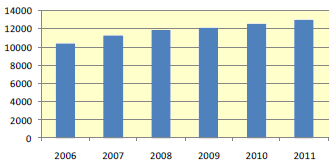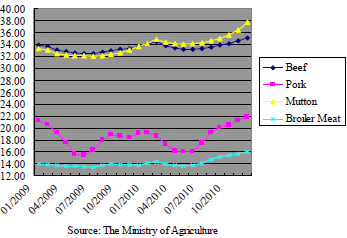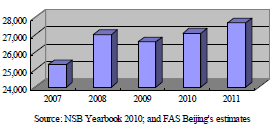



China - Poultry and Products Semi-Annual Report 2011
China's broiler meat production in 2011 will continue modest growth, rising nearly four per cent to 13 million metric tons, while broiler meat imports will decline 20 per cent to 230,000 metric tons, according to Michael Woolsey and Jianping Zhang in the latest GAIN report from USDA Foreign Agricultural Service.Executive Summary
FAS Beijing (Post) forecasts China's poultry meat production will continue higher, rising four per cent to 13 million metric tons (MMT) from an estimated 12.6MMT in the previous year. Rising broiler meat prices and are more than offsetting still high feed costs and encouraging higher production in 2011.
Broiler meat imports in 2011 (excluding chicken claws) are forecast to fall 20 per cent to 230,000 metric tons (MT) following a 28 per cent decline in 2010 due primarily to sharply lower imports from the United States resulted from China's measures of anti-dumping duties (AD) beginning February 2010 and countervailing duties (CVD) in August 2010 on US broiler products after the Chinese Ministry of Commerce (MOFCOM)'s final determinations in its AD and CVD investigations in 2010. As the measures will continue in 2011, broiler shipments to China are expected to continue to downward. Higher shipments from South America cannot completely offset reduced US shipments to China.
China's broiler meat exports in 2011 will increase nearly eight per cent to 410,000MT, following strong sales in 2010. Consumer demand in Japan and Hong Kong has been particularly brisk in 2010, and industry contacts are expecting continued strong sales in 2011.
Broiler
Broiler production in 2011 is forecast at 13MMT
China's broiler meat output is forecast to increase nearly four per cent to 13 million metric tons (MMT), following a four per cent rise in 2010. Fuelled by strong demand, Chinese broiler meat output growth is out-pacing all other meats.

2006-2011 (1,000 MT)
Strong pricing and demand for local chicken is offsetting continued high feed prices and encouraging producers to expand placements. Reduced imports from the United States following China's implementation of anti-dumping duties in February and CDC measure in August 2010 are also helping to boost local prices. Additionally, China's duck production in 2010 in South China suffered an unknown disease causing three to five per cent production losses in Guangdong, one of China's top duck producing provinces. Higher broiler demand to substitute for highly-priced red meats and reduced duck meat will likely maintain broiler prices strong at least in the first half of 2011.
A large and steadily rising inventory of grandparent (GP) generation breeding broilers is paving the way for higher commercial bird production in 2011. Chinese customs data shows that China's total breeding bird imports in 2010 increased nearly six per cent from the previous year. Chinese industry contacts estimate that China's imports of GP breeding broilers in 2010 hit a record one million sets (1 set = 120 birds), with especially strong sales in the last quarter of 2010 to prepare for higher expected output in 2011. These imports in the previous two years were 800,000 and 960,000 sets, respectively.
Higher Chinese broiler meat production is also being supported by lower rates of reported disease, as China's continued shift toward larger-sized and more standardised commercial production. While a ‘company plus contracted household farm’ model for large-scale companies has predominated to date, there is a gradual shift toward a ‘company plus production base (company's own farms) plus contracted household farms’ for broiler supplies. Meanwhile, minimum volumes for contracted household farms are also reportedly rising, in some cases to more than 5,000 birds per delivery. Previously, household farms could obtain contracts with only 2,000 birds per delivery. This has encouraged small operators to improve their production capacity and facilities.

While improving scale economies and integration is improving competitiveness, Chinese operators continue to be challenged by high feed costs. Corn normally accounts for 55-60 per cent of broiler feed. According to the Ministry of Agriculture (MOA)'s price data collected from over 400 domestic markets of farm produce, Chinese retail corn prices in December 2010 topped 2.12 yuan ($0.32) per kilo, compared to 1.87 yuan ($0.28) and 1.59 yuan ($0.24) per kilogram, respectively, in 2009 and 2008. The overall price for Chinese broiler feed (including soybean meal and other ingredients) topped 2.96 yuan ($0.45) per kilo – well above the prices in 2009 and 2008. Feed prices are expected to continue climb in 2011 because of expected tight feed grain supplies.
Total and per-capita broiler consumption on the rise
China's total broiler meat consumption in 2011 is forecast to rise three per cent to 12.8MMT (not including chicken claws), following a two per cent increase in the previous year. This will boost Chinese per capita broiler consumption to a record 10kg.

Continued demand gains are bolstered by the lower cost of broiler meat compared to Chinese red meats (chart 3). The efficient feed-grain ratio for broilers reduces production costs and helps keep broiler meat prices low. Chicken claws, wings and legs account for the vast majority of Chinese retail chicken sales. Chicken breast meat is mainly consumed at local foreign fast food chain restaurants, such as KFC and McDonald's, or local restaurants cooked with strong flavours, such as Sichuan spicy chicken dishes because breast meat is considered tasteless in China.
AQSIQ No. 136 Decree requests new labeling for meat imports as of 1 June 2011
AQSIQ (the Administration of Quality Supervision, Inspection and Quarantine) announced on its web site on 20 January 2011 the AQSIQ Decree 136 for the Administrative Measure of Inspection, Quarantine, and Supervision on Entry-Exit Meat Products effective on 1 June 2011. It replaced the AQSIQ Decree 26 for the Administrative Measure of Inspection and quarantine on Entry-Exit Meat Products announced and implemented on 22 August 2002. AQSIQ confirmed that the effective date of Decree 136 is the arrival date, not production date. Please refer to FAS Beijing's FAIRS Measures on Inspection, Quarantine, and Supervision of Entry-Exit Meat Products (11 February 2011) for a complete report. The following is a summary of key differences in Decree 136.
Article 14 (14.2) requires inner labelling for:
- Product name
- Establishment number
- Country of origin (new)
- Production lot number (new)
The definition of the ‘production lot number’ is under discussion with AQSIQ.
Article 14 (14.3) requests outer box labelling for (must mark in Chinese):
- Product name
- Establishment number
- Country of Origin (revised to specify the state/province/city)
- Specifications
- Production date
- Expiring date
- Production lot number (new)
- Storage temperature
- Destination (revised to specify: To the People?s Republic of China)
- Official inspection seal.
The ‘Country of Origin’ is changed to specify a state or province, or a city if the city does not belong to any state or province. While outer box labelling is requested to be marked in Chinese, bilingual (Chinese and English) labelling is acceptable.
Article 22 adds that if imported meat products are destined to mainland China but unloaded from original ships at Hong Kong or Macau ports and then transported to mainland China via road transportation, or unloaded at Hong Kong and Macau ports but loaded again on board a ship at other ports to destine to mainland China, (local) consignees should apply with the local inspection and quarantine agency designated by AQSIQ for transshipment pre-inspection. Without pre-inspection or pre-inspection results show meat products are not qualified, meat products are not allowed to be transshipped to the mainland.
Article 15 stresses that exporting countries meat export health certificates accompanying exported meat products should comply with AQSIQ requirements on the certificate.
Article 7 requires that imported meat products should comply with China's laws and regulations, national (GB) standard for food safety, and comply with the requirements in bilateral agreements, protocols, MOUs (memorandum of understanding), as well as requirements in bilateral trade contracts. When importing meat products that have no reference for GB standards, consignees must provide AQSIQ/CIQ (local inspection and quarantine bureaus) with a permit issued by the Chinese health administrative agency (the Ministry of Health).
Article 8 states that AQSIQ is eligible to formulate and announce inspection and quarantine requirements for imported meat products, based on China's laws, administrative regulations, national food safety standards, risk assessment for toxic and harmful products or materials in meat products due to domestic or foreign diseases, combined with an evaluation of exporting countries or areas? efficiency of safety management system; Or AQSIQ signs bilateral protocols with exporting countries or areas to identify inspection and quarantine requirements and health certificate.
Broiler meat imports are expected to fall 20 per cent
China's total broiler imports in 2011, including chicken claws, are forecast to fall 10 per cent to about 750,000MT following a nine per cent decrease in 2010, due mainly to the previously mentioned AD and CVD measures on US broiler product exports to China. Chicken claws will continue dominate imports accounting for over two-third of China's total broiler imports. Excluding chicken claws, Chinese broiler meat imports in 2011 are forecast to decline 20 per cent to 230,000MT from 287,000MT in the previous year. South America will dominate Chinese broiler meat imports.
Higher South American shipments cannot completely offset sharply lower imports from the United States due to capacity limitations on South American product. Argentina cannot supply significant volumes of mid-wings, a key import item in China. In addition, traders are reporting that quality is sometimes uneven on South American product compared to other suppliers. With tighter import supplies due to the AD/CVD action against the United States, China's broiler import prices have risen markedly, reaching $2129.12/metric ton in January 2011, up almost 50 per cent from the same month in 2010.
In 2010, overall Chinese broiler imports from the United States (including claws) fell 86 per cent due to the AD and CVD measures on US poultry products. These duties will continue in 2011, as a result of the Chinese Ministry of Commerce (MOFCOM)'s final determinations in their anti-dumping and countervailing duty investigations in 2010, which are intended to last for five years. Before China's implementation of AD and CVD duties, the United States was China's largest broiler meat supplier. Limited volumes of US claw shipments will continue despite the AD and CVD duties due to strong market prices in China.
Turkey meat imports are expected to approach 40,000MT
Given strong domestic demand and small local production, Chinese turkey meat imports in 2011 are forecast to approach 40,000MT, up about one-third from shipments in 2010. The rising sales are due mostly to higher prices for pork and broiler meat, making turkey meat a price-competitive alternative. The United States is the largest supplier to the Chinese import market accounting for almost 90 per cent of China's total imports. Local consumers normally prefer turkey middle-part wings and legs. Turkey products are mostly consumed in larger cities with better economies and more consumers willing to try new products. Roast turkey meat is often served at high-end hotels and restaurants, especially Western food restaurants, while local supermarkets provide ready-to-eat turkey cuts to home consumers.
Broiler exports in 2011 are forecast at 440,000MT
China's broiler exports in 2011 are expected to increase seven per cent to 440,000MT, following an estimated 31 per cent increase in 2010. Exporters are reporting robust growth in nearly all of China's key markets, with Japan and Hong Kong continuing to lead sales accounting for nearly 70 per cent of the total combined.
Sales to Japan are bolstered by an improving economy compared to the same period last year and shippers expect continued strong sales in 2011. In Hong Kong, mainland Chinese chicken cut imports are rising along with overall sales of fresh/chilled chicken. Environmental concerns are reducing sales of live broilers and encouraging a shift to fresh/chilled cuts, a trend that will continue to support sales to Hong Kong in 2011.
Poultry Egg
Poultry egg production in 2011 is forecast to at 27.7MMT

FAS Beijing (Post)'s current forecast of Chinese egg production remains the same as its previous forecasts in the 2010 poultry annual report. China's steady growth in poultry egg production is partly due to abundant breeding and commercial layer supplies, and partly due to improved control of avian leucosis virus (J-ALV) among egg layers, which hindered production in 2009. Narrow possibility to substitute for eggs is another factor.

Although overall Chinese chicken egg prices in 2010 climbed eight per cent to an average 8.32 yuan ($1.26) per kilo from the previous year, the profit in the egg layer breeding sector was only marginal, partly due to higher feed prices and partly due to breeding bird oversupplies. China eliminated government's subsidy for imports of grand-parent (GP) generation breeding layers in 2010, which was implemented in 2008 to encourage genetic improvement. The policy fuelled large GP breeding stock imports for two years running and resulted in oversupplies of breeding birds. Some breeding layers had to be slaughtered for meat. Meanwhile, large volume of newly developed domestic breeding egg layers are put in the market to compete with imported breeding layers. As a result, profit grains are small in the breeding sector, while most gains are taken by commercial egg production sector and marketing sector.
Like broiler production, Chinese chicken egg operators will continue to be challenged by high feed costs. Corn normally accounts for 55 to 60 per cent of chicken feed. In December 2011, Chinese retail corn prices hit a four-year record at 2.12 yuan ($0.32) per kilo. At the same time, Chinese egg layer feed prices topped 2.70 yuan ($0.41) per kilo. High production costs will continue in 2011, narrowing egg production profit. This may force some small operators withdraw from production.
Further Reading
| - | You can view the full report by clicking here. |
March 2011








